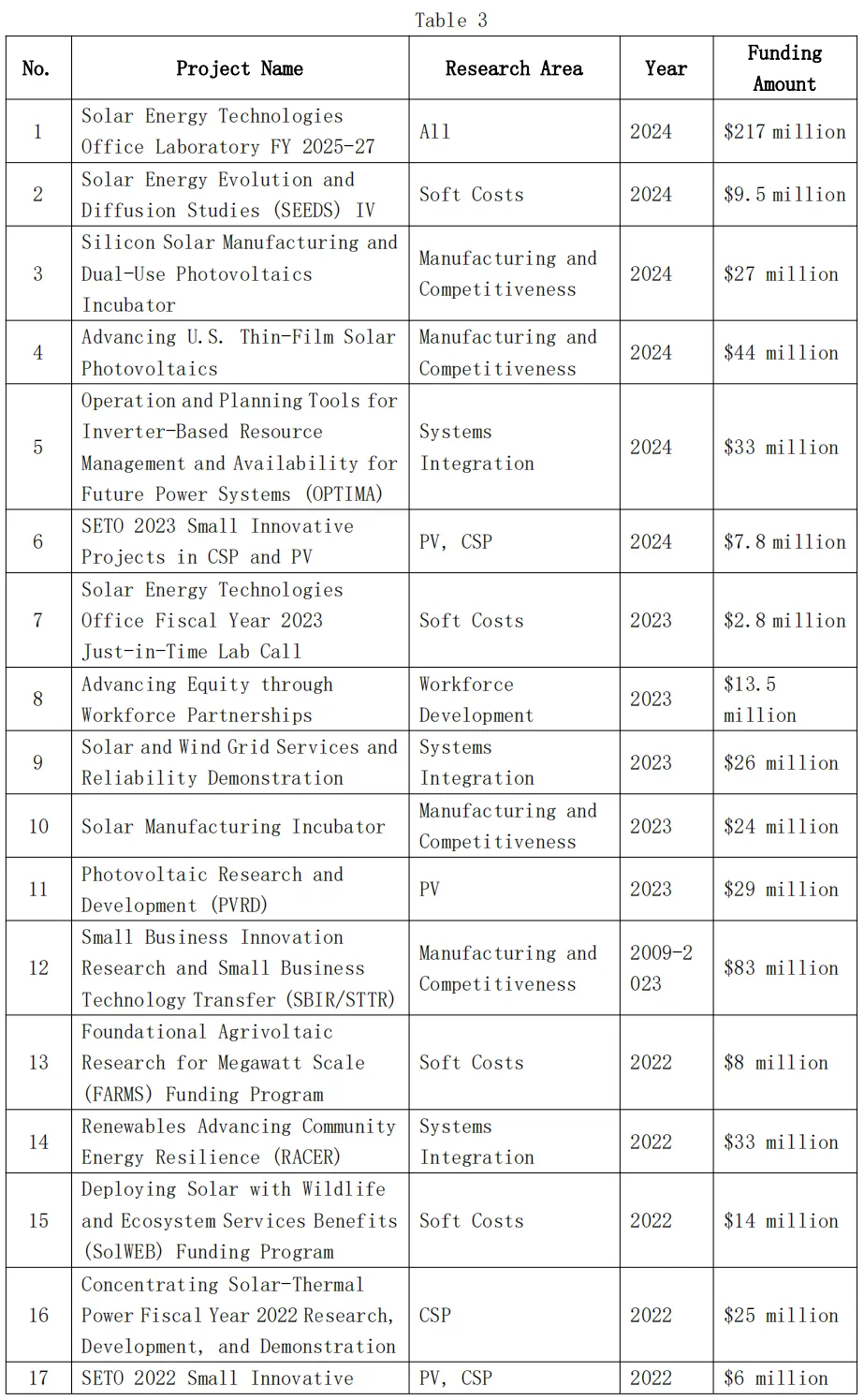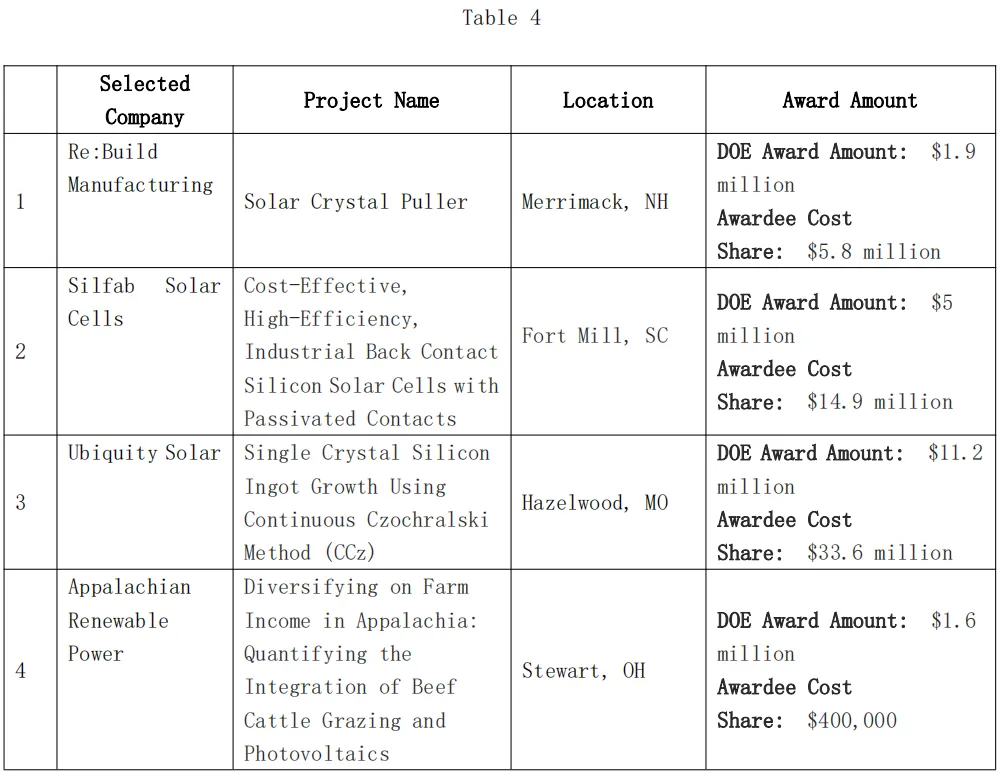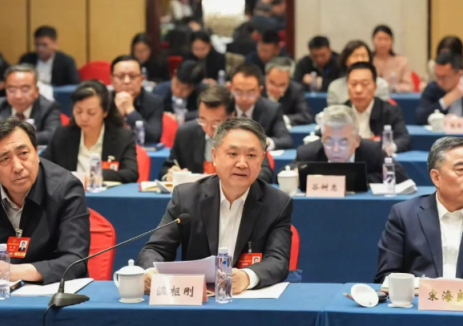光伏,是推动能源结构调整和产业绿色转型的重要产品。当前,美国一方面高筑保护主义院墙,采取多重贸易限制手段,层层加码设置光伏关税壁垒;另一方面通过《通胀削减法》和《基础设施投资与就业法》等法案,实施排他性、歧视性的产业政策,向其本土光伏产业提供大规模涉嫌违反多边规则的补贴,严重扭曲全球光伏产业链供应链的市场化运行,破坏全球共同应对气候变化等领域的国际合作。
一、美国《通胀削减法》为光伏制造和装机提供巨额补贴
美国于2022年出台的《通胀削减法》,提供高达3690亿美元补贴,以扶持包括本土光伏产品在内的清洁能源产业投资和生产,以图重构光伏产业链供应链。
(一)在光伏产品制造方面,美国联邦政府根据投资额或者产出产品的规格,向光伏企业提供税收抵免补贴。投资税收抵免总额度高达100亿美元,涵盖光伏等清洁能源制造业项目,抵免比例最高可达项目投资额的30%。生产税收抵免涵盖光伏原材料、电池片、组件和相关配套产品,具体抵免标准见表1:
得益于美国政府对光伏制造业的巨额补贴,本土企业甚至能在一边营收亏损的情况下,一边不断扩大美国本土制造业务。以美国第一太阳能公司(First Solar)为例,根据其2023年财报,该公司全年实现8.31亿美元净利润,其中约有6.597亿美元来自补贴(Government grants receivable),占比达到了79.39%,而2021年和2022年都无该项收益。2024年一季度,该公司财报实现净利润2.367亿美元,其中政府补贴2.82亿美元,即扣除政府补贴后,第一太阳能公司2024年第一季度净亏损4527万美元。这一扭亏为盈的巨大变化完全得益于美国政府对光伏产业的巨额补贴和税收抵免支持。与此同时,该公司宣布计划扩建其在俄亥俄州的光伏组件工厂,并在阿拉巴马州和路易斯安那州各新建一座光伏组件厂,总投资额高达 24 亿美元,计划将现有产能扩大4倍以上。
除组件企业外,美国光伏原材料和配件企业也获得了大量补贴。根据美国能源部近期发布的信息,美国国税局已为在35个州开发的100多个项目分配了约40亿美元的税收抵免。其中已披露的光伏项目包括:Highland Materials公司获得2.556亿美元,用于在田纳西州生产太阳能级多晶硅;Solar Cycle公司获得6400万美元,用于在佐治亚州生产太阳能玻璃。
此外,为配合《通胀削减法》生产税收抵免政策的实施,美国能源部贷款项目办公室向本土晶体硅光伏制造商Qcells提供14.5亿美元贷款担保,支持其在佐治亚州卡特斯维尔的光伏产业链项目。该项目建成后将生产硅锭、硅片、电池片和成品光伏电池组件,并将成为美国有史以来最大的硅锭和硅片厂,补充美国本土光伏产业链中的关键缺口。
(二)在光伏发电项目方面,美国《通胀削减法》对本土光伏发电项目主要提供四类税收抵免政策,具体见表2。值得注意的是,这四类补贴政策中,如果项目满足“国内含量”要求,均将获得额外的税收抵免额度。“国内含量”是指项目使用了一定比例的在美国开采、生产或制造的钢、铁或制成品,涉嫌违反世贸组织规则下的“国民待遇”义务。
(三)户用光伏应用方面,2023年6月28日,拜登政府宣布了“人人享有太阳能”(Solar for All)计划,这是《通胀削减法》中总计270亿美元的“温室气体减排基金”的重要组成部分。该计划旨在提供70亿美元拨款,用于补贴住宅屋顶和社区分布式太阳能项目,以降低安装和使用太阳能的成本。
二、美国对光伏技术研发提供大量拨款补贴
美国能源部太阳能技术办公室(Solar Energy Technologies Office,SETO)每年设立资助计划,为光伏研发和示范项目提供直接资助,资金来源为能源部和《基础设施投资与就业法》。2024年5月16日,美国能源部宣布投资7100万美元,其中包括来自《基础设施投资与就业法》的1600万美元,用于资助“晶硅光伏制造和两用光伏技术孵化器资助计划”(2700万美元)和“推进美国薄膜太阳能光伏技术资助计划”(4400万美元),解决国内光伏供应链制造能力的差距。
(一)光伏研发和示范项目资助
根据美国能源部太阳能技术办公室发布的信息,2022年至今,该机构在执行的光伏研发和示范项目资助计划共有19项,共计6.156亿美元。具体见表3:
(二)晶硅光伏制造和两用光伏技术孵化器资助计划
晶硅光伏制造和两用光伏技术孵化器资助计划(表3第3项)额度为2700万美元,为开发下一代太阳能技术的项目提供支持。2024年5月16日,美国能源部太阳能技术办公室公布了10个入选项目。具体见表4:
(三)推进美国薄膜太阳能光伏发电资助计划
推进美国薄膜太阳能光伏技术资助计划(表3第4项),为本土薄膜光伏技术的研究、开发和示范项目拨款4400万美元。美国能源部太阳能技术办公室于2024年5月16日公布了资助结果。具体见表5:
三、美国对光伏行业的地方补贴措施种类多、数量众
美国各州和地方层面也出台了众多补贴措施以支持光伏产业的发展。DSIRE数据库收录了美国各州层面的针对光伏产业及其技术发展的财政激励措施共计419项,包括:返利计划(87项)、优惠贷款(76项)、财产税优惠(72项)、清洁能源融资计划(35项)、销售税优惠(34项)和赠款计划(29项)等。各州相比,最多的科罗拉多州有26项财政激励政策,德克萨斯州为25项,加利福尼亚州为18项。
以科罗拉多州为例,科罗拉多州阿斯彭市的返利计划,为商业和住宅光伏发电提供激励,标准为前6千瓦补贴200美元/千瓦,此后按100美元/千瓦补贴,上限为3400美元或25千瓦。科罗拉多州能源智能能效返利计划还对太阳能光伏系统提供项目成本的25%(最高2500美元)的补贴。
在优惠融资方面,科罗拉多州制定了一项全州范围的PACE(Property Assessed Clean Energy,即清洁能源分期)计划,允许商业业主为节能和可再生能源项目的前期费用,申请100%的融资额,业主可有最长20年的融资期限。科罗拉多州清洁能源基金的住宅能源升级贷款计划为住宅安装太阳能光伏设施提供无首付低利率最高7.5万美元最长20年的贷款。
在财产税优惠政策方面,科罗拉多州自2006年7月1日起,免除了用于可再生能源发电的所有组件销售、储存和使用的州销售和使用税。对于住宅而言,由住宅业主拥有并生产供住宅财产使用的能源的可再生能源个人财产免征科罗拉多州财产税。
在直接赠款方面,科罗拉多州的博尔德市通过太阳能补助计划提供根据系统容量每瓦1美元的资助,最高上限为8000美元或总成本的50%。
四、美国光伏补贴政策充分体现“双重标准”,并将导致“产能过剩”
近期,美国频繁指责中国新能源行业存在大量补贴,同时,自己却通过实施排他性、歧视性的补贴政策,大肆扩张自身产能,是典型的“双重标准”行径,并且将导致美国光伏产业出现“产能过剩”,冲击全球光伏行业的健康发展。《通胀削减法》实施后,美国计划建设的光伏产能大幅增长。根据美国太阳能产业协会(SEIA)统计,截至2023年10月,美国本土有25条组件生产线和2家多晶硅供应商、9家逆变器供应商、2家光伏玻璃供应商、1家背板供应商;共有运营中组件产能13GW,多晶硅4万吨;正在建设中的有19.4GW的组件产能和各3.3GW的电池、硅片、铸锭产能;已宣布计划设厂的另有45GW的电池产能、80GW的组件产能、14GW的铸锭产能和27GW的硅片产能。据美国咨询公司伍德麦肯兹统计,根据目前已公布的规划,2026年美国光伏组件产能将超过120GW,是届时本土光伏装机需求的3倍。
以《通胀削减法》为代表的美国光伏补贴政策,罔顾多边经贸规则,将使用美国国内商品而非进口商品作为补贴获得条件,是赤裸裸的违背“国民待遇”义务的歧视性政策。中国已于2024年3月26日将美国《通胀削减法》中的相关补贴政策诉至世界贸易组织。与美国磋商无果后,中国于7月15日申请世贸组织就审理该案成立专家组。无论如何包装美化,都无法改变美国光伏补贴政策的歧视性、违规性和保护主义本质。
Huge Illegal Subsidies on U.S. Solar Industries Distort Global PV Market
Solar photovoltaic (PV) products are crucial for the adjustment of energy structure and the green transformation of industries. Currently, the United States has built high walls of protectionism by imposing multiple trade restrictions and continuously increasing tariff barriers on imported PV products. On the other hand, it implemented exclusive and discriminatory industrial policies through legislation such as the Inflation Reduction Act (IRA) and the Infrastructure Investment and Jobs Act (IIJA), and subsidized its own PV industry in a large scale which violated the multilateral trade rules and severely distorted the market operations of the global supply chain of PV industry and impeded international cooperation in areas such as climate change.
I.The U.S. Inflation Reduction Act provides unprecedented subsidies for PV manufacturing and installation
The Inflation Reduction Act, introduced in 2022, offers subsidies of an unprecedented $369 billion to support investments and production in the clean energy sector, including domestic photovoltaic products, aiming to reconstruct the PV industry chain.
i.In terms of PV manufacturing, the U.S. federal government provides tax credits to PV companies based on their investment amount or product specifications, which amount to $10 billion, covering projects in the clean energy manufacturing sector, including PV, with credit rates reaching up to 30% of the investment. Photovoltaic raw materials, cells, modules, and supporting products are all eligible for tax credits, with specific standards listed in Table 1.
Benefiting from substantial government subsidies, American PV companies are able to continuously expand their manufacturing in the country while facing revenue losses. Take First Solar as an example. According to its 2023 financial report, the company achieved a net profit of $830.777 million, with approximately $659.745 million labeled as government grants receivable, accounting for 79.39% of its profit. This part of income did not exist in 2021 and 2022. In the first quarter of 2024, the company reported a net profit of $236.616 million, with government grant amounting to $281.889 million. Without the subsidies, First Solar would have incurred a net loss of $45.27 million during that period. This significant turnaround was entirely due to the huge amount of government subsidies and tax credit. Meanwhile, the company announced plans to expand its PV module factory in Ohio and to build new factories in Alabama and Louisiana with $2.4 billion of investment, aiming to quadruple its current capacity.
In addition to module manufacturers, companies of raw material and accessories in the industry have also received plenty of subsidies. According to the U.S. Department of Energy, the Internal Revenue Service has allocated approximately $4 billion in tax credits for more than 100 projects developed in 35 states. Among the voluntarily disclosed PV projects were Highland Materials, which received $255.6 million for producing solar-grade polysilicon in Tennessee, and SolarCycle, which received $64 million for producing solar glass in Georgia.
Additionally, to support the implementation of the production tax credit policy under the IRA, the U.S. Department of Energy"s Loan Programs Office has provided a $1.45 billion loan guarantee to domestic crystalline silicon photovoltaic manufacturer Qcells, which supports its PV industry chain project in Cartersville, Georgia. Once completed, the project will produce silicon ingots, wafers, cells, and finished PV modules, making it the largest silicon ingot and wafer plant in the country, addressing a critical gap in its domestic PV supply chain.
ii. For PV power generation, the Inflation Reduction Act provides four main types of tax credits for domestic projects, as illustrated in Table 2. Notably, for each of these four subsidy policies, projects that meet the requirements in domestic content will receive an additional tax credit. Domestic content refers to using a certain proportion of steel, iron, or manufactured goods, mined, produced, or manufactured in the United States, which may violate the WTO’s national treatment principle.
iii. For residential PV applications, on June 28, 2023, the Biden administration announced the Solar for All initiative, which is a key component of the $27 billion Greenhouse Gas Reduction Fund under the IRA. This initiative provides $7 billion for residential rooftop and community distributed solar projects, reducing the cost of PV installation and usage.
II.The U.S. provides substantial grants and subsidies for the research and development of photovoltaic technologies
The U.S. Department of Energy"s Solar Energy Technologies Office (SETO) establishes annual funding programs to provide direct support for PV research and development, and demonstration projects, funded by the Department of Energy and the IIJA. On May 16, 2024, the Department of Energy announced a $71 million investment, including $16 million from the IIJA, to fund the The Silicon Solar Manufacturing and Dual-Use Photovoltaics Incubator Program ($27 million) and the Advancing U.S. Thin-Film Solar Photovoltaics Funding Program ($44 million), aiming to close gaps in PV supply chain manufacturing capabilities.
i.Funding for PV R&D and Demonstration Projects
According to SETO of the U.S. Department of Energy, since 2022, 19 PV research and development, and demonstration project funding programs have been implemented, totaling $615.6 million, with details listed in Table 3.
ii.Silicon Solar Manufacturing and Dual-Use Photovoltaics Incubator
The Silicon Solar Manufacturing and Dual-Use Photovoltaics Incubator Program (No. 3 in Table 3) deploys $27 million to support the development of the next-generation solar technologies. On May 16, 2024, SETO announced 10 selected projects as listed in Table 4:
iii. Advancing the U.S. Thin-Film Solar Photovoltaics Funding Program
The Advancing U.S. Thin-Film Solar Photovoltaics Funding Program (No. 4 in Table 3) has allocated $44 million for local research, development, and demonstration projects on two major thin-film photovoltaic technologies. The U.S. Department of Energy Solar Energy Technologies Office announced the funding results on May 16, 2024. See Table 5 for the details.
III.Numerous local subsidies for the U.S solar industry
State and local governments in the U.S. have also launched numerous subsidies for the solar industry. The DSIRE database records 419 state-level fiscal incentives for the industry and its technological advancement, including rebate programs (87), loan programs (76), property tax incentives (72), PACE financing programs (35), sales tax incentives (34), and grant programs (29). Among all, Colorado enjoys the most financial incentive policies with 26, followed by Texas with 25, and California with 18.
In Colorado, the City of Aspen Rebate Program offers incentives for commercial and residential solar PV installations. The rebate is $200/kW for the first 6 kilowatts and $100/kW thereafter, with a maximum of $3,400 or 25 kilowatts. The Roaring Fork Valley Energy Smart Colorado Energy Efficiency Rebate Program provides a rebate of 25% of the project cost for solar PV systems, up to $2,500.
In terms of favorable financing, Colorado has implemented a statewide Property Assessed Clean Energy (PACE) program that allows commercial property owners to finance 100% of the upfront costs for energy efficiency and renewable energy projects, with financing terms up to 20 years. The Colorado Clean Energy Fund"s Residential Energy Upgrade (RENU) Loan Program offers no-money-down, low-interest loans up to $75,000 for up to 20 years for residential solar PV installations.
Regarding property tax incentives, since July 1, 2006, Colorado has exempted state sales and use tax for all components used to produce AC electricity from renewable energy. For residential properties, renewable energy personal property owned and used by residential property owners to produce energy for residential use is exempt from Colorado property tax.
As for direct grants, the city Boulder in Colorado provides funding through the Solar Grant Program, which offers $1/W, with a maximum of $8,000 or 50% of the total cost.
IV.The solar subsidy policies in the U.S. reflects double standards and will lead to overcapacity
In recent years, the U.S. has frequently accused China"s new energy sector of excessive subsidies. Simultaneously, it is aggressively expanding its solar capacity through exclusive and discriminatory subsidy policies, demonstrating typical double standards. These actions will lead to overcapacity in the U.S. and impact the healthy industry development worldwide. After the implementation of the Inflation Reduction Act, planned solar capacity in America has significantly increased. According to the Solar Energy Industries Association (SEIA), as of October 2023, the U.S. has 25 module production lines, 2 polysilicon suppliers, 9 inverter suppliers, 2 photovoltaic glass suppliers, and 1 backsheet supplier. The operating capacity includes 13GW of modules and 40,000 tons of polysilicon. Under construction are 19.4GW of module capacity and 3.3GW each of cell, wafer, and ingot capacity. Additionally, there are announced plans for 45GW of cell capacity, 80GW of module capacity, 14GW of ingot capacity, and 27GW of wafer capacity. According to Wood Mackenzie, based on current plans, U.S. solar module capacity will exceed 120GW by 2026, three times of the domestic demand for solar installations at that time.
The U.S. solar subsidy policies, represented by the Inflation Reduction Act, disregard multilateral trade rules, making the use of domestic goods rather than imported goods a condition for obtaining subsidies. These discriminatory policies blatantly violate the U.S.’s national treatment obligation under the WTO rules. On March 26, 2024, China filed a complaint with the WTO regarding the relevant policies in the U.S. Inflation Reduction Act. After unsuccessful consultations with the U.S., China requested the WTO to establish a panel to review the case on July 15. Regardless of its camouflage, the subsidies demonstrate the clear essence of violation of rules,discrimination and protectionism of the U.S.solar subsidy policy.
来源:中国光伏行业协会CPIA





























 光伏头条
光伏头条 风电头条
风电头条 储能头条
储能头条 充换电头条
充换电头条 氢能汇
氢能汇 能课堂
能课堂 国际能源网
国际能源网